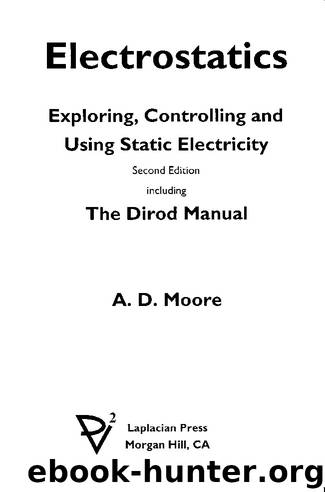Electrostatics by A. D. Moore

Author:A. D. Moore [Moore, A. D.]
Language: eng
Format: epub
Tags: Science / Alternative
Published: 0101-01-01T00:00:00+00:00
Unexpected Shocks from Capacitors
Follow me closely. I connect my sphere gap and my 50 pF capacitor to a Dirod. I open the gap wide, charge the capacitor, and then stop the generator. Slowly closing the gap, I observe that it sparks at 45 kV. Then I know that the capacitor had been charged to that voltage. All right. The spark has discharged the system, hasn’t it? Maybe. We find out. I continue to close the gap, slowly. It sparks again, at perhaps 15 kV. There was a very considerable remaining charge! That oscillatory first spark died out before all charge was removed. So: if I want to discharge completely, I had better close the gap completely, and short-circuit (that is, “short”) the system.
But there is more to be said, and the safety bulletin mentioned earlier says it. Many high-grade capacitors in use today will recover a fair part of the original energy storage if left on open circuit after complete discharge. They may do this in minutes, or in months, depending on the dielectric used. There may be as much as 10 percent recovery of the original voltage.
In your experimenting, you may decide to let off a really wicked spark by getting some large war-surplus capacitors. I don’t recommend it. But if you do it take every precaution while experimenting. Run no risks. When done, be sure to short the capacitors, and put them away. Don’t remove that short. If you do, this residual effect might give someone a terrific jolt, even months later.
Download
This site does not store any files on its server. We only index and link to content provided by other sites. Please contact the content providers to delete copyright contents if any and email us, we'll remove relevant links or contents immediately.
| Automotive | Engineering |
| Transportation |
Whiskies Galore by Ian Buxton(41506)
Introduction to Aircraft Design (Cambridge Aerospace Series) by John P. Fielding(32874)
Small Unmanned Fixed-wing Aircraft Design by Andrew J. Keane Andras Sobester James P. Scanlan & András Sóbester & James P. Scanlan(32554)
Craft Beer for the Homebrewer by Michael Agnew(17916)
Turbulence by E. J. Noyes(7679)
The Complete Stick Figure Physics Tutorials by Allen Sarah(7114)
Kaplan MCAT General Chemistry Review by Kaplan(6564)
The Thirst by Nesbo Jo(6420)
Bad Blood by John Carreyrou(6257)
Modelling of Convective Heat and Mass Transfer in Rotating Flows by Igor V. Shevchuk(6214)
Learning SQL by Alan Beaulieu(6009)
Weapons of Math Destruction by Cathy O'Neil(5803)
Man-made Catastrophes and Risk Information Concealment by Dmitry Chernov & Didier Sornette(5620)
Digital Minimalism by Cal Newport;(5351)
Life 3.0: Being Human in the Age of Artificial Intelligence by Tegmark Max(5164)
iGen by Jean M. Twenge(5141)
Secrets of Antigravity Propulsion: Tesla, UFOs, and Classified Aerospace Technology by Ph.D. Paul A. Laviolette(4891)
Design of Trajectory Optimization Approach for Space Maneuver Vehicle Skip Entry Problems by Runqi Chai & Al Savvaris & Antonios Tsourdos & Senchun Chai(4829)
Electronic Devices & Circuits by Jacob Millman & Christos C. Halkias(4724)
